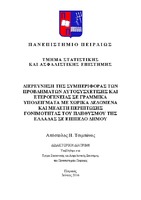Διερεύνηση της συμπεριφοράς των προβλημάτων αυτοσυσχέτισης και ετερογένειας σε γραμμικά υποδείγματα με χωρικά δεδομένα και μελέτη περίπτωσης γονιμότητας του πληθυσμού της Ελλάδας σε επίπεδο δήμου
Investigating the behaviour of autocorrelation and heterogeneity problems in linear models with spatial data and a case study of fertility of the population of Greece at local authority level

Προβολή/
Λέξεις κλειδιά
Χωρικά δεδομένα ; Χωρική οικονομετρία ; Οικονομετρικά υποδείγματα ; Χωρική αυτοσυσχέτιση ; Χωρική ανάλυση ; Στοχαστικές διαδικασίες ; Γραμμικός προγραμματισμός ; Ανάλυση παλινδρόμησης ; Χωρική ετερογένεια ; ΔημογραφίαΠερίληψη
Η εκτίμηση υποδειγμάτων γραμμικής παλινδρόμησης με χωρικά δεδομένα, δηλαδή με διαστρωματικά δεδομένα που έχουν συλλεχθεί και προέρχονται από διαφορετικές γεωγραφικές περιοχές, εμπεριέχει σοβαρούς κινδύνους εξ’ αιτίας της εμφάνισης των χωρικών επιδράσεων οι οποίες εάν αγνοηθούν από τον ερευνητή επηρεάζουν την αξιοπιστία των αποτελεσμάτων. Οι χωρικές επιδράσεις, που οφείλονται στη φύση των δεδομένων, αποτελούνται από τη χωρική εξάρτηση και τη χωρική ετερογένεια. Ειδικότερα, χωρική εξάρτηση σημαίνει ότι οι τιμές μιας μεταβλητής δεν είναι μεταξύ τους ανεξάρτητες αλλά εξαρτώνται σύμφωνα με τη γεωγραφική τους θέση δημιουργώντας συστάδες παρατηρήσεων. Χωρική ετερογένεια σημαίνει ότι η σχέση ανάμεσα στις εξεταζόμενες μεταβλητές δεν παραμένει σταθερή σε ολόκληρη τη γεωγραφική περιοχή αλλά μεταβάλλεται από σημείο σε σημείο. Η αντιμετώπιση των χωρικών επιδράσεων γίνεται με την ενσωμάτωση τους στο υπόδειγμα μέσω της εξειδίκευσης χωρικών οικονομετρικών υποδειγμάτων. Η διατριβή αυτή ασχολείται με θέματα που αφορούν τα προβλήματα της χωρικής εξάρτησης και της χωρικής ετερογένειας στο γραμμικό υπόδειγμα παλινδρόμησης. Πιο συγκεκριμένα η δομή της διατριβής έχει ως εξής. Στο Κεφάλαιο 1 γίνεται μια σύντομη εισαγωγή στη μεθοδολογία της χωρικής ανάλυσης παρουσιάζοντας τις ιδιαιτερότητες των χωρικών δεδομένων και την κατασκευή της μήτρας χωρικών σταθμίσεων. Επιπρόσθετα, παρουσιάζονται οι βασικές χωρικές διαδικασίες και τα βασικά χωρικά οικονομετρικά υποδείγματα. Στο Κεφάλαιο 2 εξετάζεται, χρησιμοποιώντας προσομοίωση, η συμπεριφορά των LΜ έλεγχων χωρικής εξάρτησης και εξειδίκευσης που εφαρμόζονται για την ανίχνευση του προβλήματος της χωρικής αυτοσυσχέτισης στα σφάλματα ενός γραμμικού υποδείγματος και την επιλογή του κατάλληλου χωρικού οικονομετρικού υποδείγματος. Τα αποτελέσματα που προέκυψαν από τη διαδικασία της προσομοίωσης επιβεβαιώνουν παλιότερα, γνωστά στη βιβλιογραφία της χωρικής οικονομετρίας, συμπεράσματα για τη συμπεριφορά αυτών των ελέγχων στα μικρά και μέτρια δείγματα και συνεισφέρουν περαιτέρω πληροφορίες για τη συμπεριφορά τους στα μεγάλα δείγματα. Επιπρόσθετα, στο ίδιο κεφάλαιο παρουσιάζεται το φαινόμενο της υποφαινομενικής παλινδρόμησης ως μια άλλη αιτία που οδηγεί σε χωρική αυτοσυσχέτιση στα σφάλματα ενός οικονομετρικού υποδείγματος. Με τη βοήθεια προσομοίωσης για δυο ανεξάρτητες στάσιμες χωρικές αυτοπαλίνδρομες διαδικασίες πρώτης τάξης, SAR (1) εντοπίζονται οι ομοιότητες στην εμφάνιση του φαινομένου στα χωρικά δεδομένα με τα δεδομένα των χρονοσειρών. Ωστόσο, εάν ο ερευνητής ακολουθήσει τις υποδείξεις από την εφαρμογή των ελέγχων χωρικής εξάρτησης και εκτιμήσει κάποιο χωρικό οικονομετρικό υπόδειγμα δεν εμφανίζεται το πρόβλημα της υποφαινομενικής παλινδρόμησης. Στο Κεφάλαιο 3 πραγματοποιούνται μια σειρά προσομοιώσεων με σκοπό τη διερεύνηση της συμπεριφοράς της γεωγραφικά σταθμισμένης παλινδρόμησης που συνήθως χρησιμοποιείται στην αντιμετώπιση του προβλήματος της χωρικής ετερογένειας μέσω της εκτίμησης τοπικών υποδειγμάτων καθώς και των ελέγχων που εξετάζουν τη συνεισφοράς της. Τα αποτελέσματα δείχνουν ότι, παρά την καλή εφαρμογή και τα πλεονεκτήματα της μεθόδου, υπάρχουν περιπτώσεις που μπορεί να οδηγήσουν σε παραπλανητικά αποτελέσματα. Στο ίδιο κεφάλαιο εισάγεται η έννοια της τοπικής υποφαινομενικής παλινδρόμησης και μελετάται το πρόβλημα για δυο ανεξάρτητες στάσιμες χωρικές αυτοπαλίνδρομες διαδικασίες πρώτης τάξης, SAR (1). Το βασικό συμπέρασμα είναι ότι ο ερευνητής θα πρέπει να είναι ιδιαίτερα προσεχτικός όταν εκτιμά τοπικά υποδείγματα με τη μέθοδο της γεωγραφικά σταθμισμένης παλινδρόμησης διότι μπορεί να εμφανιστεί σε τοπικό επίπεδο υποφαινομενική συμπεριφορά που δεν μπορεί να αποφευχθεί σε αντίθεση με το ίδιο πρόβλημα στο ολικό επίπεδο που αντιμετωπίζεται. Στο Κεφάλαιο 4 γίνεται προσπάθεια να ερμηνευθούν εμπειρικά οι χωρικές διαφοροποιήσεις και τα πρότυπα στις σχέσεις μεταξύ του επιπέδου της γονιμότητας του πληθυσμού της Ελλάδας και ενός αριθμού επιλεγμένων κοινωνικό - οικονομικών δεικτών σε τοπικό διοικητικό επίπεδο λαμβάνοντας υπ’ όψη τη παρουσία της χωρικής ετερογένειας. Η εκτίμηση του υποδείγματος με τη μέθοδο της γεωγραφικά σταθμισμένης παλινδρόμησης και η χαρτογράφηση των αποτελεσμάτων αποκαλύπτουν ότι σε επίπεδο δήμων υπάρχουν σημαντικές διαφοροποιήσεις τόσο στην κατεύθυνση όσο και στην ένταση των επιδράσεων των κοινωνικών και οικονομικών παραγόντων στα επίπεδα της γονιμότητας.


